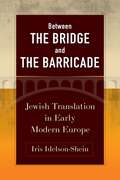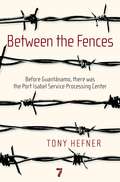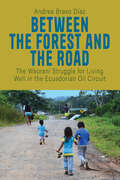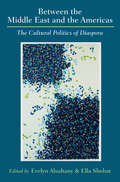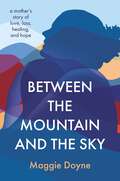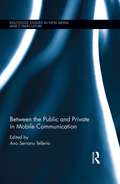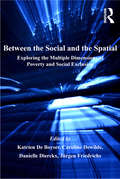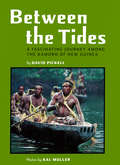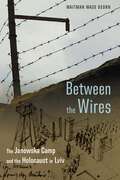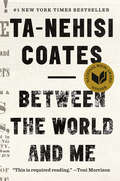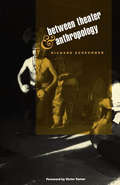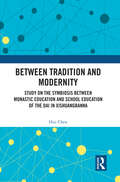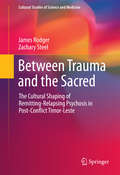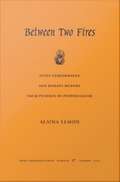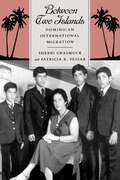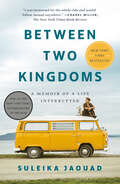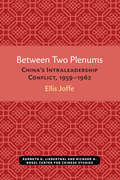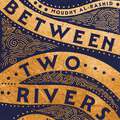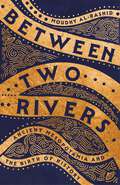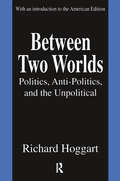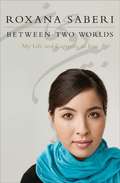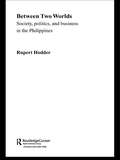- Table View
- List View
Between the Bridge and the Barricade: Jewish Translation in Early Modern Europe (Jewish Culture and Contexts)
by Iris Idelson-SheinBetween the Bridge and the Barricade explores how translations of non-Jewish texts into Jewish languages impacted Jewish culture, literature, and history from the sixteenth century into modern times. Offering a comprehensive view of early modern Jewish translation, Iris Idelson-Shein charts major paths of textual migration from non-Jewish to Jewish literatures, analyzes translators’ motives, and identifies the translational norms distinctive to Jewish translation. Through an analysis of translations hosted in the Jewish Translation and Cultural Transfer (JEWTACT) database, Idelson-Shein reveals for the first time the liberal translational norms that allowed for early modern Jewish translators to make intensely creative and radical departures from the source texts—from “Judaizing” names, places, motifs, and language to mistranslating and omitting material both deliberately and accidently. Through this process of translation, Jewish translators created a new library of works that closely corresponded with the surrounding majority cultures yet was uniquely Jewish in character.As a site of intense negotiation between different cultures, communities, religions, readers, genres, and languages, these translations become an ideal entry point into the complex relationships between early modern Christians and Jews. At the same time, they also pose a significant challenge for modern-day scholars. But, for the careful reader, who can navigate the labyrinth of unacknowledged translations of non-Jewish sources into Jewish languages, there awaits a terrain of surprising intercultural encounters between Jews and Christians. Between the Bridge and the Barricade uncovers the hitherto hidden non-Jewish corpus that, Idelson-Shein contends, played a decisive role in shaping early modern Jewish culture.
Between the Conquests: The Early Chicano Historical Experience (4th edition)
by Michael R. OrnelasThis book is a unique collection of readings covering this early period--the span of history between the 16th century Spanish conquest and the United States conquest of Mexico in the Mexican American War--with a special focus on the distinctive Chicano experience.
Between the Fences: Before Guantanamo, there was the Port Isabel Service Processing Center
by Tony HefnerSomething at the Texas detention facility is terribly wrong, and Tony Hefner knows it. But the guards are repeatedly instructed not to speak of anything they witness. In the Rio Grande Valley, one of the most poverty-stricken areas in the United States, good jobs are scarce and the detention facility pays the best wages for a hundred miles. The guards follow orders and keep quiet.For six years, Tony Hefner was a security guard at the Port Isabel Service Processing Center, one of the largest immigration detention centers in America, and witnessed alarming corruption and violations of basic human rights. Officers preyed upon the very people whom they are sworn to protect. On behalf of the 1,100 men, women, and children residing there on an average day, and the 1,500 new undocumented immigrants who pass through its walls every month, this is the story of the systematic sexual, physical, financial, and drug-related abuses of detainees by guards.
Between the Forest and the Road: The Waorani Struggle for Living Well in the Ecuadorian Oil Circuit
by Andrea Bravo DíazDuring the past two decades Ecuadorians have engaged in a national debate around Buen Vivir (living well). This ethnography discusses one of the ways in which people experience well-being or aspire to live well in Ecuadorian Amazonia. Waponi Kewemonipa (living well) is a Waorani notion that embraces ideas of good conviviality, health and certain ecological relations. For the Waorani living along the oil roads, living well has taken many pathways. Notably, they have developed new spatial organizations as they move between several houses, and navigate between the economy of the market and the economy of the forest.
Between the Forest and the Road: Contemporary Transnational Television and Film
by Stephan Ehrig, Benjamin Schaper Elizabeth WardAudiences for contemporary German film and television are becoming increasingly transnational, and depictions of German cultural history are moving beyond the typical post-war focus on Germany’s problematic past. Entertaining German Culture explores this radical shift, building on recent research into transnational culture to argue that a new process of internal and external cultural reabsorption is taking place through areas of mutually assimilating cultural exchange such as streaming services, an increasingly international film market, and the import and export of Anglo-American media formats.
Between the Middle East and the Americas: The Cultural Politics of Diaspora
by Alsultany Evelyn Shohat EllaBetween the Middle East and the Americas: The Cultural Politics of Diaspora traces the production and circulation of discourses about "the Middle East" across various cultural sites, against the historical backdrop of cross-Atlantic Mahjar flows. The book highlights the fraught and ambivalent situation of Arabs/Muslims in the Americas, where they are at once celebrated and demonized, integrated and marginalized, simultaneously invisible and spectacularly visible. The essays cover such themes as Arab hip-hop's transnational imaginary; gender/sexuality and the Muslim digital diaspora; patriotic drama and the media's War on Terror; the global negotiation of the Prophet Mohammad cartoons controversy; the Latin American paradoxes of Turcophobia/Turcophilia; the ambiguities of the bellydancing fad; French and American commodification of Rumi spirituality; the reception of Iranian memoirs as cultural domestication; and the politics of translation of Turkish novels into English. Taken together, the essays analyze the hegemonic discourses that position "the Middle East" as a consumable exoticized object, while also developing complex understandings of self-representation in literature, cinema/TV, music, performance, visual culture, and digital spaces. Charting the shifting significations of differing and overlapping forms of Orientalism, the volume addresses Middle Eastern diasporic practices from a transnational perspective that brings postcolonial cultural studies methods to bear on Arab American studies, Middle Eastern studies, and Latin American studies. Between the Middle East and the Americas disentangles the conventional separation of regions, moving beyond the binarist notion of "here" and "there" to imaginatively reveal the thorough interconnectedness of cultural geographies.
Between the Mountain and the Sky: A Mother’s Story of Love, Loss, Healing, and Hope
by Maggie DoyneBetween the Mountain and the Sky shows us the goodness that is possible when a single person--regardless of age--takes action to help another and, in the process, changes the lives of hundreds. Maggie&’s story begins in suburban New Jersey, in a comfortable middle-class family that supports her decision to travel the world during a gap year before starting college. During her travels, the trajectory of her life alters when she has a surprise encounter with a Nepali girl breaking rocks in a quarry. Maggie decides to invest her life savings of five thousand dollars to buy a piece of land and open a children&’s home in Nepal.That home becomes Kopila Valley Children&’s Home, and eventually, the nonprofit Maggie launches, the BlinkNow Foundation, also starts the Kopila Valley School, which provides tuition-free education for more than four hundred students. Maggie and BlinkNow&’s work have been recognized around the world for their innovative, sustainable work.However, this book isn&’t a how-to for fledging philanthropists or nonprofit founders--it&’s a coming-of-age story about a young woman suspended between two worlds, as well as the love, loss, healing, and hope she experiences along the way. And Maggie&’s inspiring, intimate tale shows readers an important truth: the power to change the world exists within all of us.
Between the Public and Private in Mobile Communication (Routledge Studies in New Media and Cyberculture)
by Ana Serrano TelleríaMobile devices’ impact on daily life has raised relevant questions regarding public and private space and communication. Both the technological environment (operating systems, platforms, apps) and media ecosystems (interface design, participatory culture, social media) influence how users deal with the public and private, intimate and personal spheres. Leading researchers in communication, art, computer engineering, education, law, sociology, philosophy, and psychology here explore current methodologies for studying the dichotomy of the public and private in mobile communication, providing a foundation for further research.
Between the Social and the Spatial: Exploring the Multiple Dimensions of Poverty and Social Exclusion
by Katrien De Boyser Jürgen FriedrichsSince the beginning of the 1990s, the gradual widening of scientific and policy debates on poverty from a narrow focus on income poverty to a more inclusive concept of social exclusion, has made poverty research both more interesting and more complicated. This transition to a more multidimensional conceptualization of poverty forms the background and starting point of this book. Researchers studying the 'social' and 'spatial' dimensions of poverty have only started to challenge and explore the boundaries of each other's research perspectives and instruments. This book brings together these different bodies of literature on the intersection of spatial and social exclusion for the first time, by providing a state-of-the art review written by internationally-recognized experts who critically reflect on the theoretical status of their research on social exclusion, and on the implications this has for future research and policy-making agendas.
Between the Tides
by David PickellEighteen thousand Kamoro live along the southwestern coast of New Guinea. Their ancestors first roamed this land more than 50,000 years ago. By the early 1960s, just 50 years after the arrival of missionaries and colonial administrators, the unique culture of the Kamoro had been driven to the verge of extinction. Or so it was thought until photographer Kal Muller stumbled upon an initiation ceremony and found that traditional Kamoro life was still alive and thriving. This work provides an account of a culture that is rapidly disappearing and the wrenching process of change that the Kamoro have had to endure. It presents a portrait of how an isolated, nomadic past meets a worldly, urban future, and how history confronts superstition.
Between the Wires: The Janowska Camp and the Holocaust in Lviv
by Waitman Wade BeornBetween the Wires tells for the first time the history of the Janowska camp in Lviv, Ukraine. Located in a city with the third-largest ghetto in Nazi-occupied Europe, Janowska remains one of the least-known sites of the Holocaust, despite being one of the deadliest. Simultaneously a prison, a slave labor camp, a transit camp to the gas chambers, and an extermination site, this hybrid camp played a complex role in the Holocaust. Based on extensive archival research, Between the Wires explores the evolution and the connection to Lviv of this rare urban camp. Waitman Wade Beorn reveals the exceptional brutality of the SS staff alongside an almost unimaginable will to survive among prisoners facing horrendous suffering, whose resistance included an armed uprising. This integrated chronicle of perpetrators, victims, and bystanders follows the history of the camp into the postwar era, including attempts to bring its criminals to justice.
Between the World and Me
by Ta-Nehisi Coates“This is your country, this is your world, this is your body, and you must find some way to live within the all of it.”<P><P> In a profound work that pivots from the biggest questions about American history and ideals to the most intimate concerns of a father for his son, Ta-Nehisi Coates offers a powerful new framework for understanding our nation’s history and current crisis. Americans have built an empire on the idea of “race,” a falsehood that damages us all but falls most heavily on the bodies of black women and men—bodies exploited through slavery and segregation, and, today, threatened, locked up, and murdered out of all proportion. What is it like to inhabit a black body and find a way to live within it? And how can we all honestly reckon with this fraught history and free ourselves from its burden?<P> Between the World and Me is Ta-Nehisi Coates’s attempt to answer these questions in a letter to his adolescent son. Coates shares with his son—and readers—the story of his awakening to the truth about his place in the world through a series of revelatory experiences, from Howard University to Civil War battlefields, from the South Side of Chicago to Paris, from his childhood home to the living rooms of mothers whose children’s lives were taken as American plunder. Beautifully woven from personal narrative, reimagined history, and fresh, emotionally charged reportage, Between the World and Me clearly illuminates the past, bracingly confronts our present, and offers a transcendent vision for a way forward.<P> <b>Winner of the National Book Award</b> <p> <b>Winner of the 2016 Alex Award (10 best adult books that appeal to teen audiences)</b> <P><b> Nominee for the 2018 Young Reader's Choice Award </b> <i>(Pacific Northwest Library Association)</i>
Between Theater and Anthropology
by Victor Turner Richard SchechnerIn performances by Euro-Americans, Afro-Americans, Native Americans, and Asians, Richard Schechner has examined carefully the details of performative behavior and has developed models of the performance process useful not only to persons in the arts but to anthropologists, play theorists, and others fascinated (but perhaps terrified) by the multichannel realities of the postmodern world.Schechner argues that in failing to see the structure of the whole theatrical process, anthropologists in particular have neglected close analogies between performance behavior and ritual. The way performances are created--in training, workshops, and rehearsals--is the key paradigm for social process.
Between Tradition and Modernity: Study on the Symbiosis Between Monastic Education and School Education of the Dai in Xishuangbanna
by Hui ChenHow to deal with the relationship between tradition and modernity has become a global concern under the impact of pluralism. This book explores the relationship between traditional Dai culture and modern school education through a field study in the Dai region of Xishuangbanna, Yunnan, China. The study analyses the reasons for conflicts between monastic education and modern school education in the Dai region of Xishuangbanna. It also discusses the logic behind the formation of the Dai people’s belief in Southern Theravada Buddhism and its importance in Dai culture. Through the analysis of the changes in monastic education before and after the intervention of the modern school system, the study finds symbiosis in the differences and conflicts between these two forms of education. The author proposes a symbiosis theory of multiple educational forms in ethnic areas and offers targeted solutions to specific problems between the Dai monastic education and modern school education in Xishuangbanna. This book will be a great read to students and scholars of Chinese studies, ethnic studies, education, and those who are interested in multi- ethnicity issues in general.
Between Trauma and the Sacred: The Cultural Shaping of Remitting-Relapsing Psychosis in Post-Conflict Timor-Leste (Cultural Studies of Science and Medicine)
by James Rodger Zachary SteelThe relatively frequent occurrence of rapid onset and very brief, but often florid, psychotic states, with periodic recurrence, alongside relatively low rates of PTSD and chronic psychosis, were unexpected findings from the 2004 East Timor Mental Health Study, conducted in the context of the country's recently won independence and in the wake of the atrocities endured in the protracted fight for sovereignty. Further unanticipated was the frequent association of recurrence with the time of the new moon (fulan lotuk) and other times or places of sacred (lulik) or associated cultural significance. The perceived violation of culturally sacrosanct lulik obligations often also appeared to foreshadow the initial onset of such patterns of distress. Significant episodes of trauma and loss appeared a hidden feature of affected individuals histories, which we argue have become symbolically entwined with local cultural understandings of ritual obligation, sacredness, and taboo. -ansi-language:EN-GB;mso-fareast-language: EN-US;mso-bidi-language:AR-SA;mso-bidi-font-style:italic"> This volume develops a dynamic but contextualized multi-level formulation of psychosis and psychotic-symptoms, able to incorporate a range of factors from the biological, through the sociocultural, to the political. The work is truly interdisciplinary drawing on both the quantitative and qualitative findings of our own study but further supported through local ethnography and broader anthropological enquiry into the outcomes of psychosis in non-Western settings; psychoanalysis and psychoanalytic anthropology; evidence and theory exploring links between trauma, dissociation and psychosis; and novel culturally-adaptable psychosocial focused interventions for psychosis. We situate both evidence and theorising in wider epistemological and political context, including in relation to the movement for Global Mental Health. Culturally patterned presentations of brief remitting-relapsing psychosis are ultimately conceived as the trade-off between competing fragmentary and synthetic forces: the former in part secondary to the lasting and deleterious effects of overwhelming loss, trauma and adversity; the latter emboldened by cultural meaning and social response in the context of broad ecological pressures demanding survival and resilience.
Between Two Absolutes: Public Opinion And The Politics Of Abortion
by Elizabeth Adell CookThis book examines the shape and direction of public attitudes toward abortion. It looks at the social and demographic basis of public opinion on the abortion issue. The book is also concerned with the consequences of abortion politics.
Between Two Fires: Gypsy Performance and Romani Memory from Pushkin to Postsocialism
by Alaina LemonSince tsarist times, Roma in Russia have been portrayed as both rebellious outlaws and free-spirited songbirds--in each case, as if isolated from society. In Soviet times, Russians continued to harbor these two, only seemingly opposed, views of "Gypsies," exalting their songs on stage but scorning them on the streets as liars and cheats. Alaina Lemon's Between Two Fires examines how Roma themselves have negotiated these dual images in everyday interactions and in stage performances. Lemon's ethnographic study is based on extensive fieldwork in 1990s Russia and focuses on Moscow Romani Theater actors as well as Romani traders and metalworkers. Drawing from interviews with Roma and Russians, observations of performances, and conversations, as well as archives, literary texts, and media, Lemon analyzes the role of theatricality and theatrical tropes in Romani life and the everyday linguistics of social relations and of memory. Historically, the way Romani stage performance has been culturally framed and positioned in Russia has served to typecast Gypsies as "natural" performers, she explains. Thus, while theatrical and musical performance may at times empower Roma, more often it has reinforced and rationalized racial and social stereotypes, excluding them from many Soviet and Russian economic and political arenas. Performance, therefore, defines what it means to be Romani in Russia differently than it does elsewhere, Lemon shows. Considering formal details of language as well as broader cultural and social structures, she also discusses how racial categories relate to post-Soviet economic changes, how gender categories and Euro-Soviet notions of civility are connected, and how ontological distinctions between "stage art" and "real life" contribute to the making of social types. This complex study thus serves as a corrective to romantic views of Roma as detached from political forces.
Between Two Islands: Dominican International Migration
by Sherri Grasmuck Patricia R. PessarPopular notions about migration to the United States from Latin America and the Caribbean are too often distorted by memories of earlier European migrations and by a tendency to generalize from the more familiar cases of Mexico and Puerto Rico. Between Two Islands is an interdisciplinary study of Dominican migration, challenging many widespread, yet erroneous, views concerning the socio-economic background of new immigrants and the causes and consequences of their move to the United States.Eschewing monocausal treatments of migration, the authors insist that migration is a multifaceted process involving economic, political, and socio-cultural factors. To this end, they introduce an innovative analytical framework which includes such determinants as the international division of labor; state policy in the sending and receiving societies; class relations; transnational migrant households; social networks; and gender and generational hierarchies.By adopting this multidimensional approach, Grasmuck and Pessar are able to account for many intriguing paradoxes of Dominican migration and development of the Dominican population in the U.S. For example, why is it that the peak in migration coincided with a boom in Dominican economic growth? Why did most of the immigrants settle in New York City at the precise moment the metropolitan economy was experiencing stagnation and severe unemployment? And why do most immigrants claim to have achieved social mobility and middle-class standing despite employment in menial blue-collar jobs?Until quite recently, studies of international migration have emphasized the male migrant, while neglecting the role of women and their experiences. Grasmuck and Pessar's attempt to remedy this uneven perspective results in a better overall understanding of Dominican migration. For instance, they find that with regard to wages and working conditions, it is a greater liability to be female than to be without legal status. They also show that gender influences attitudes toward settlement, return, and workplace struggle.Finally, the authors explore some of the paradoxes created by Dominican migration. The material success achieved by individual migrant households contrasts starkly with increased socio-economic inequality in the Dominican Republic and polarized class relations in the United States.This is an exciting and important work that will appeal to scholars and policymakers interested in immigration, ethnic studies, and the continual reshaping of urban America.
Between Two Kingdoms: A Memoir of a Life Interrupted
by Suleika JaouadIn the summer after graduating from college, Suleika Jaouad was preparing, as they say in commencement speeches, to enter “the real world.” She had fallen in love and moved to Paris to pursue her dream of becoming a war correspondent. The real world she found, however, would take her into a very different kind of conflict zone. <p><p> It started with an itch—first on her feet, then up her legs, like a thousand invisible mosquito bites. Next came the exhaustion, and the six-hour naps that only deepened her fatigue. Then a trip to the doctor and, a few weeks shy of her twenty-third birthday, a diagnosis: leukemia, with a 35 percent chance of survival. <p><p> Just like that, the life she had imagined for herself had gone up in flames. By the time Jaouad flew home to New York, she had lost her job, her apartment, and her independence. She would spend much of the next four years in a hospital bed, fighting for her life and chronicling the saga in a column for The New York Times. <p><p> When Jaouad finally walked out of the cancer ward—after countless rounds of chemo, a clinical trial, and a bone marrow transplant—she was, according to the doctors, cured. But as she would soon learn, a cure is not where the work of healing ends; it’s where it begins. <p><p> She had spent the past 1,500 days in desperate pursuit of one goal—to survive. And now that she’d done so, she realized that she had no idea how to live. How would she reenter the world and live again? How could she reclaim what had been lost? <p><p> Jaouad embarked—with her new best friend, Oscar, a scruffy terrier mutt—on a 100-day, 15,000-mile road trip across the country. She set out to meet some of the strangers who had written to her during her years in the hospital: a teenage girl in Florida also recovering from cancer; a teacher in California grieving the death of her son; a death-row inmate in Texas who’d spent his own years confined to a room. What she learned on this trip is that the divide between sick and well is porous, that the vast majority of us will travel back and forth between these realms throughout our lives. <p><p> Between Two Kingdoms is a profound chronicle of survivorship and a fierce, tender, and inspiring exploration of what it means to begin again. <p> <b>New York Times Bestseller</b>
Between Two Plenums: China’s Intraleadership Conflict, 1959–1962 (Michigan Monographs In Chinese Studies #22)
by Ellis JoffeThe origins of the Cultural Revolution are still shrouded in uncertainty. Crucial questions either remain unanswered or have been given answers which derive from conflicting interpretations. To what period can the direct origins of the Cultural Revolution be traced? What issues, if any, divided the leadership, and how deep were these divisions? What was the state of power relations and what was Mao’s position? Why did developments in the period preceding the Cultural Revolution reach a climax in such a convulsion? Between Two Plenums examines these questions as they apply to the years 1959–1962. At base, the perspective of pre-Cultural Revolution politics adopted therein is that of “conflict” rather than “consensus.” From this vantage point, the Eighth and Tenth Plenums loom in retrospect as important watersheds in the development of the intraleadership conflict which culminated in the great upheaval.
Between Two Rivers: 'A WONDERFUL READ' -- TOM HOLLAND
by Moudhy Al-Rashid'I have never read a book on Mesopotamia that so beautifully brings to life the people themselves ... It melts away the sense of time. A wonderful read.'TOM HOLLAND'A tender, moving and vivid history of ancient Mesopotamia and how it still speaks to us.' ROBERT MACFARLANE 'Fascinating and magnificent, beautifully written and explained: this book is a masterpiece.' GEORGE MONBIOT'Ancient Mesopotamia comes alive in Moudhy Al-Rashid's must-read, millennia-spanning history ... spellbinding.' NEW SCIENTIST ---------- Thousands of years ago, in a part of the world we now call ancient Mesopotamia, people began writing things down for the very first time. What they left behind, in a vast region between the Tigris and Euphrates rivers, preserves leaps in human ingenuity, like the earliest depiction of a wheel and the first approximation of pi. But they also capture breathtakingly intimate, raw and relatable moments, like a dog's paw prints as it accidentally stepped into fresh clay, or the imprint of a child's teeth. In Between Two Rivers, historian Dr Moudhy Al-Rashid reveals what these ancient people chose to record about their lives, allowing us to brush hands with them millennia later. We find a lullaby to soothe a baby, instructions for exorcising a ghost, countless receipts for beer, and the adorable, messy writing of preschoolers. We meet an enslaved person negotiating their freedom, an astronomer tracing the movement of the planets, a princess who may have created the world's first museum, and a working mother struggling with 'the juggle' in 1900 BCE. Together, these fragments illuminate not just the history of Mesopotamia, but the story of how history was made. ©2025 Moudhy Al-Rashid (P)2025 Hodder & Stoughton Limited
Between Two Rivers: 'A WONDERFUL READ' -- TOM HOLLAND
by Moudhy Al-Rashid'I have never read a book on Mesopotamia that so beautifully brings to life the people themselves ... It melts away the sense of time. A wonderful read.'TOM HOLLAND'A tender, moving and vivid history of ancient Mesopotamia and how it still speaks to us.' ROBERT MACFARLANE 'Fascinating and magnificent, beautifully written and explained: this book is a masterpiece.' GEORGE MONBIOT'Ancient Mesopotamia comes alive in Moudhy Al-Rashid's must-read, millennia-spanning history ... spellbinding.' NEW SCIENTIST ---------- Thousands of years ago, in a part of the world we now call ancient Mesopotamia, people began writing things down for the very first time. What they left behind, in a vast region between the Tigris and Euphrates rivers, preserves leaps in human ingenuity, like the earliest depiction of a wheel and the first approximation of pi. But they also capture breathtakingly intimate, raw and relatable moments, like a dog's paw prints as it accidentally stepped into fresh clay, or the imprint of a child's teeth. In Between Two Rivers, historian Dr Moudhy Al-Rashid reveals what these ancient people chose to record about their lives, allowing us to brush hands with them millennia later. We find a lullaby to soothe a baby, instructions for exorcising a ghost, countless receipts for beer, and the adorable, messy writing of preschoolers. We meet an enslaved person negotiating their freedom, an astronomer tracing the movement of the planets, a princess who may have created the world's first museum, and a working mother struggling with 'the juggle' in 1900 BCE. Together, these fragments illuminate not just the history of Mesopotamia, but the story of how history was made.
Between Two Worlds: Politics, Anti-Politics, and the Unpolitical
by Richard HoggartThroughout his life, Richard Hoggart has been involved with four main areas: broadcasting, arts policy, education, and social work, all of which he finds have characteristics in common. This collection of essays represents less than a quarter of his essays published over the last two decades. The subjects, to which he turned again and again and which recur in public debate, are still current and contemporary. His views on culture and society, on literature and censorship, and on higher education are both unique and timely.The volume is divided into six parts. Part 1, "Society and Culture: Home and Away," discusses the question, "Are museums political?"; the use of the battered word culture in relation to UNESCO; and the end of the public service idea. Part 2, "A Very English Voice," looks at the rural English culture and country of D. H. Lawrence, and examines the controversy and censorship involved with three of Lawrence's works: The Rainbow, Women in Love, and Lady Chatterley's Lover. Part 3, "Politics and Literature," reveals the author's penchant for timely debates on such subjects as "The State versus Literature" and "Freedom to Publish: Even Hateful Stuff"; and his thoughts on reviewers and reviewing. Part 4, "Levels of Education," touches upon the subjects of politics in universities; the use of public funds for various purposes presumed to be socially valuable; academics in the marketplace; and the need for government to foster critical and cultivated literacy. Part 5, "Figures from a Distant Past," contains reminiscences on and portraits of Hoggart's close relationships and family. Part 6, "Summing Up and Signing Off," is an interview with Nicolas Tredell in which Hoggart discusses his life's work and concerns.Written in Hoggart's characteristically graceful but direct style, these essays touch on issues of contemporary importance in his unique manner. This volume will be of interest to scholars and general readers interested in culture studies, communications, and education.
Between Two Worlds: My Life and Captivity in Iran
by Roxana SaberiA chronicle of the Iranian-American journalist's imprisonment, as well as a look at Iran and its political tensions.
Between Two Worlds - Society, Politics, and Business in the Philippines
by Rupert HodderThis book considers the tensions and complementarities between two different attitudes towards social relationships - on the one hand, the attitude aspired to in the West, which emphasises individualism, institutional probity, and the rule of law, and which regards social relationships as ideals or absolutes; and, on the other hand, the attitude often found in Asia, where loyalties based on kinship, local networks, and places of origin are vitally important, and where social relationships, institutions and practices are often material for manipulation and the pursuit of ambition. The book explores the nature of these different attitudes, discussing the different attitudes as they are found in practice in the Philippines. It considers how they are bound up with material progress, and how they have a crucial impact, on business, politics and region-centre relations.
